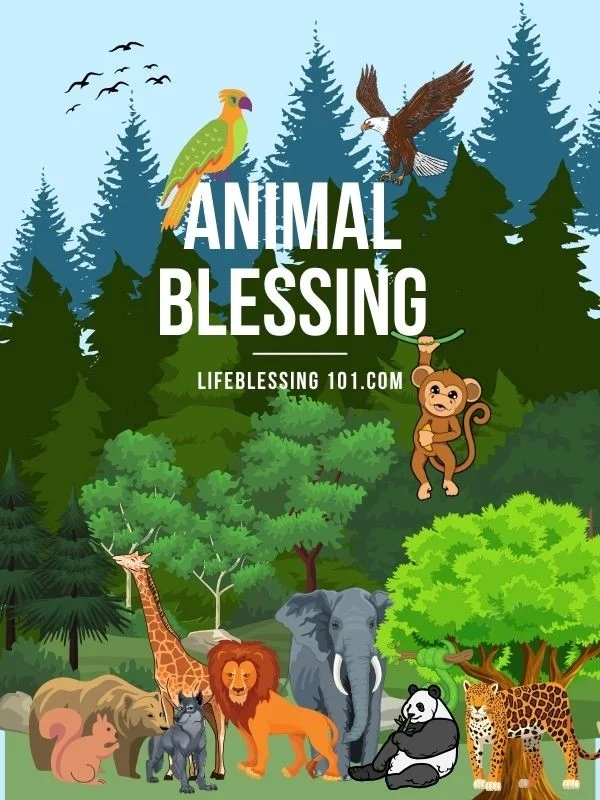
In every corner of the world, animals walk beside us as companions, protectors, and teachers of silent love. Across America, animal blessings have grown into a touching symbol of compassion and gratitude — a spiritual reminder that all life is sacred. Whether it’s a child bringing their puppy to a church courtyard or a priest gently blessing a horse in a village field, these ceremonies reflect a deep truth: humans and animals share a divine bond that transcends language and culture.
In modern times, communities come together each year to celebrate this connection through faith-based animal care and pet blessing ceremonies. These heartfelt gatherings unite families, strengthen community ties, and remind us that kindness toward animals is a reflection of God’s own love.
The Spiritual Meaning Behind Animal Blessings
Blessing animals is far more than a religious gesture — it’s an act of love. It acknowledges that every creature is part of creation’s harmony. When a priest or pastor extends a prayer over a cat, a dove, or a service dog, they’re not only asking for protection — they’re affirming that animals carry a spark of divine life within them.
Faith leaders often remind us that the way humans treat animals mirrors their spiritual health. Compassion toward animals teaches patience, humility, and gratitude — virtues deeply rooted in every faith. Through these blessings, we learn to see beyond ourselves, recognizing that animals, too, play a sacred role in the divine story of existence.
Historical Roots of Animal Blessings
The roots of animal blessings stretch back to the thirteenth century with St. Francis of Assisi, the patron saint of animals and ecology. St. Francis believed that all living beings — from the tiniest bird to the mightiest horse — were his brothers and sisters. His prayers for animals became a foundation for modern blessings, and his feast day on October 4th is now celebrated around the world as the official Blessing of the Animals Day.
In ancient times, farmers prayed for their livestock, asking for abundant harvests and healthy herds. These prayers reflected gratitude for the animals that helped sustain human life. As centuries passed, these agricultural rituals evolved into community blessings held in churches and town squares — moments filled with music, laughter, and heartfelt prayers for all creatures.
Today, that same spirit continues. In every blessing, people see St. Francis’s message reborn: a reminder that to care for animals is to honor the Creator.
Culturally Significant Animals in Spiritual Traditions

Every culture has seen animals as messengers of the divine.
In Native American spirituality, each creature holds a sacred meaning — the eagle represents courage, the wolf symbolizes loyalty, and the bear reflects strength and healing. These beliefs teach people to live in balance with nature, respecting every life form as sacred.
In Christian traditions, animals often symbolize divine virtues: the lamb stands for purity, the dove for peace, and the fish for faith. St. Francis’s gentle relationship with animals further strengthened the Christian belief that God’s love flows through every living being.
In Hinduism, the cow is revered as a giver of life and nourishment, while in Buddhism, the elephant symbolizes patience and spiritual wisdom. In Islam, the Prophet Muhammad taught mercy toward all creatures, saying that every kindness shown to an animal is rewarded by God.
Together, these traditions reveal a universal truth — that animals connect humans to spirituality and teach lessons no words can express.
Symbolism Across Faiths
Animals appear throughout sacred texts and religious stories.
- In Christianity, the dove reminds believers of peace after the Great Flood, while the lamb symbolizes innocence and sacrifice.
- In Buddhism, monks often release birds and fish as acts of compassion, symbolizing freedom and non-violence.
- In Native traditions, the bear represents introspection and courage, guiding people through hardship.
- In Hinduism, Lord Ganesha’s companion — the mouse — teaches humility, showing that even the smallest creature has purpose.
These stories remind us that each animal, in its own way, mirrors a spiritual truth — courage, purity, humility, or love. To bless an animal, therefore, is to celebrate these divine lessons in living form.
Animal Blessings in Modern America

In today’s America, animal blessings have evolved into joyful, community-wide events. Each October, churches, shelters, and parks fill with families carrying pets of all shapes and sizes — wagging tails, fluttering wings, and gentle purrs fill the air.
The St. Francis Day Blessing is especially popular in cities like New York, San Francisco, and Chicago, where priests sprinkle holy water over hundreds of animals gathered in courtyards and cathedrals. These moments are not only deeply spiritual but also profoundly healing.
In a society where stress and isolation are common, these blessings remind people of the power of love — love that expects nothing in return, just as animals love unconditionally.
Places and Events That Bless Animals
| Place | Event | Frequency |
| St. John the Divine, New York | St. Francis Day Blessing | Annual |
| Grace Cathedral, San Francisco | Pet Blessing Ceremony | Annual |
| St. Mark’s Church, Chicago | Blessing of the Pets Service | Annual |
| Local Animal Shelters | Community Blessing & Adoption Day | Seasonal |
| City Parks & Faith Centers | Interfaith Animal Blessing Event | Seasonal |
These gatherings not only honor animals but also inspire gratitude and empathy. Families come together to celebrate love, while communities learn that caring for creation is a shared spiritual responsibility.
The Rise of Animal Chaplaincy
In recent years, a new and beautiful ministry has emerged — animal chaplaincy. These are trained spiritual caregivers who support people through the joys and sorrows of animal companionship.
When someone loses a beloved pet, an animal chaplain offers pet memorial prayers, guiding them through grief and helping them find comfort in faith. Some chaplains even lead animal hospice prayers, providing compassion during a pet’s final moments.
Through this work, chaplains remind people that love never dies — it transforms. By blessing animals and comforting their owners, they expand the meaning of faith to include every creature under heaven.
Types of Animals Blessed
While dogs and cats often take the spotlight, animal blessings embrace creatures of all kinds. Horses, rabbits, birds, and reptiles — even farm animals like goats and cows — receive blessings.
Some churches also organize wildlife blessings, praying for endangered species and ecological balance. Others host animal rescue blessings, honoring organizations that save neglected or abused animals.
Every prayer, whether whispered over a tiny hamster or a majestic horse, carries the same message: every life is worthy of love and respect.
The Emotional Benefits of Blessing Animals

Blessing an animal is as healing for the owner as it is for the pet. When families gather to offer prayers, they experience peace, empathy, and gratitude. Children learn compassion, understanding that animals feel joy, fear, and love just like humans do.
Studies show that caring for animals reduces anxiety and increases emotional resilience. Spiritually, it teaches humility — a reminder that the world isn’t ours alone, but shared with all living beings.
Blessings, therefore, are not just ceremonies — they’re lessons in love.
Animal Blessings in Popular Culture
Hollywood has often portrayed the sacred bond between humans and animals. Movies like Marley & Me, Hachi: A Dog’s Tale, and The Art of Racing in the Rain show how loyalty and love can feel divine.
Social media has also amplified these events. Photos and videos of church pet blessing ceremonies USA spread joy across platforms like Instagram and YouTube. Celebrities and influencers join community pet blessing days, inspiring millions to honor their pets spiritually.
These digital moments turn faith into something shareable — proof that compassion is universal.
How to Bless Your Pet at Home
You don’t have to wait for a church event to bless your pet.
Here’s a simple way to offer your own home blessing ritual:
- Find a peaceful spot. Sit with your pet, away from distractions.
- Light a candle or say a prayer. Thank God for the joy and companionship your pet brings.
- Gently place your hand on your pet. Say words of protection and love, such as:
“May you be blessed with peace, health, and happiness. You are loved by God and by me.” - End with gratitude. Offer a treat or gentle affection as a symbol of love.
This small act transforms everyday care into a moment of holiness.
Real-Life Stories

A woman from Chicago once shared, “When the priest blessed my golden retriever, I felt my faith strengthen. It reminded me that love itself is a prayer.”
In New York, a family attended their first church pet blessing service and said their children learned what true compassion means.
Such experiences prove that these ceremonies are more than rituals — they’re opportunities to renew faith, love, and gratitude.
Animal Blessings Around the World
Outside the United States, animal blessings take many forms.
In Mexico, people bring pets to church on the Feast of St. Anthony, patron of animals.
In the Philippines, animals are decorated with flowers for blessings.
In Italy, thousands gather each year in Assisi — the hometown of St. Francis — to celebrate the global connection between humans and animals.
These international traditions highlight that love for animals is not bound by culture or religion — it’s a universal language of compassion.
The Future of Faith-Based Animal Care
As awareness grows about environmental and animal welfare, faith-based compassion for animals is becoming stronger than ever. Churches collaborate with shelters, offering blessings alongside adoption events. Schools teach children about spiritual responsibility toward animals.
This movement — often called eco-spirituality — connects faith with care for creation. It reminds us that protecting animals is not just kindness; it’s sacred duty.
The future of animal blessings lies in unity — communities coming together to nurture both spirit and nature.
Conclusion
Animal blessings are not merely ceremonies — they are expressions of divine love. They remind us that every creature, big or small, reflects the Creator’s grace. When we bless an animal, we honor not just their life, but the eternal bond that connects all living beings.
Whether in a grand cathedral or a quiet backyard, each blessing whispers the same truth: Love is sacred. Compassion is faith. And every heartbeat, human or animal, belongs to the same divine symphony.
FAQs
Q1: What is an animal blessing?
An animal blessing is a spiritual ceremony where prayers are offered for the protection, health, and happiness of animals.
Q2: When do most churches hold pet blessings?
Most churches hold animal blessings on St. Francis Day (October 4th) each year.
Q3: Can any animal receive a blessing?
Yes, all animals — from dogs and cats to birds and horses — can be blessed.
Q4: What kind of prayers are used?
Common prayers include gratitude, healing, and protection for pets and wildlife.
Q5: Can I bless my pet at home?
Absolutely. You can say a short prayer, thank your pet for companionship, and ask for divine protection.
Q6: Why are animal blessings important?
Because they celebrate love, respect for creation, and the sacred connection between humans and animals.

